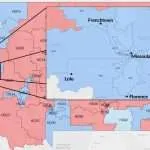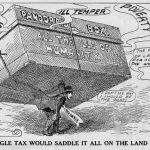Opinion
David Rand
Inclusionary Zoning with a Pipe Wrench: How Bozeman’s WARD Initiative Will Stop Housing Cold
A well-intentioned water measure in my hometown turns access to basic infrastructure into a price-fixing mandate—guaranteeing less housing, not more.
Oct 24, 2025
By David Rand
Opinion Contributor
A new ballot measure in Bozeman, the “Water Adequacy for Residential Development” initiative—or WARD—is being sold as a clever way to protect our water and make housing more affordable. In reality, it’s Inclusionary Zoning with a pipe wrench in its hand, wielding the city’s water supply as a bludgeon against property rights in Bozeman.
Under WARD, any new housing project with three or more units could only tap Bozeman’s “cash-in-lieu of water rights” system only if one-third of its units are permanently deed-restricted as “affordable.” Everyone else—any builder without a third of their project locked into below-market prices—would have to go out and acquire water rights on their own before breaking ground. Adding years and hundreds of thousands of dollars in legal and engineering work to their projects.
That means for most builders, the only practical option would be: don’t build in Bozeman.
The illusion of trade-off-free affordability
Inclusionary zoning (IZ) policies like this rest on a comforting illusion—that the city can “require” affordability simply by writing it into the code. Economics says otherwise. When a law demands that 33% of a project be sold or rented below market price, that cost doesn’t vanish. It gets absorbed somewhere else. Developers can’t print money; they build only when the expected return exceeds the risk-adjusted cost of capital.
If one-third of their units must be sold at a loss, the only way to make the numbers pencil is to:
- Increase the price of the remaining two-thirds.
- Reduce the total project scale or quality.
- Cancel the project outright.
And when risk and uncertainty rise—like being told the city might not approve your water supply—more projects land in category three.
Why not just implement inclusionary zoning? Because it is illegal now. Bozeman had inclusionary zoning with zero effect on housing prices before the legislature banned the practice in 2021. Why was it banned? Because it doesn’t work. The state legislature also banned rent controls for the same reason: economic laws – when ignored – create disaster for Montanans.
The economics of risk and profit are not optional.
Housing isn’t like social work. It’s a capital-intensive, multi-year risk venture. Developers front the money long before they see a dime back, betting on future interest rates, rent levels, and construction materials and labor costs. Making guesses about what the market wants and figuring out how it can be delivered in a high-uncertainty, highly competitive time.
When policymakers impose new conditions—say, “secure water rights on your own or give away a third of your product at cost”—they raise risk and shrink margins. The rational reaction isn’t greed; it’s arithmetic. Investors move their money to less hostile markets.
That’s why so many studies of inclusionary zoning find the same result:
- No increase in total units built (link)
- Upward pressure on overall prices (link)
- Geographic flight of construction out of town, where the rules don’t apply. This means more sprawl and more pressure to turn grazing pasture into condos. (link)
The social function of prices
How can I predict this outcome with such confidence? Beyond the evidence from the studies, which can always have their challenges, the reasoning is based on price theory.
Prices are not arbitrary. They are the language a free society uses to communicate decentralized information that consumers and producers need to make decisions and solve problems. Every price carries information: how much of something exists, how badly people want it, and how difficult it is to produce. When that signal is allowed to move freely, it guides entrepreneurs, builders, and investors toward what people need most — and away from what’s wasteful or unsustainable. All other things being equal.
Profits are not a moral flaw in that system; they’re the reward for taking risks in an uncertain world. A high potential profit signals that something valuable is scarce — and invites entrepreneurs to create more of it.
But when the government cuts into those profits through mandates or rationing, it doesn’t reduce developer “greed.” It erases the signal that tells society where to invest effort and capital. The most risk-averse investors flee first, the most ambitious follow, and soon nothing gets built.
That’s what WARD does: it distorts the price signal for housing by replacing the natural feedback loop of supply and demand with political bias. It assumes planners can substitute their good intentions for the actual process of building homes. They can’t.
A scarcity story that feeds on itself
Proponents pitch WARD as a way to secure Bozeman’s long-term water supply. But water scarcity isn’t what’s stopping construction; regulatory-created scarcity is. Bozeman already holds enough water rights to serve roughly twice its current population in normal years.
What’s truly scarce is the political permission to build dense, middle-market housing where people actually want to live—close to jobs, schools, and transit. By tying water access to affordability mandates, WARD would drive new homes into the county, onto wells and septic systems, creating precisely the kind of sprawl that strains water, traffic, and infrastructure the most.
The irony is complete: in the name of conservation, WARD ensures less efficient land use and higher per-capita water consumption.
The moral temptation of control
WARD’s moral appeal is seductive for some: use regulation to make the market fair. But fairness that ignores incentives is doomed to fail. You can’t make homes affordable by making it illegal to profit from building them.
Bozeman’s housing shortage isn’t caused by stingy developers or “greedy landlords.” Too few homes with high demand cause it. Prices rise because supply lags behind demand, not because profit margins are too high. And when a city weaponizes water, it does not engender a sense of belonging for those who build our homes, risking their capital on the next housing project.
Like rent control, these policies attempt to help an interest group in the short run, but prevent larger social progress in the long run. For example, after Argentina removed its rental controls in 2024, the country has seen a massive explosion in new rental supply and a 30 percent drop in prices. These huge swings are uniquely contextual to the history of Argentina, but they show the economic laws at play. But never let that slow down a progressive, as Mamdami’s upcoming experiment in New York will show.
Economic reasoning also shows us how aligned interests can create interesting bedfellows in politics—called the bootlegger and baptist phenomenon. People who would not normally coalition under a policy find themselves suddenly aligned on the ends while having vastly different motives. I can only assume the progressives who are advancing the environmental angle to get price fixing are genuinely motivated by the idea that with smart enough policy, economic laws can be “fixed” to produce “fair” outcomes for low-income folks. They are the true believing Baptists of the moment.
Enter the Gallatin Valley Sentinel’s “conservative” take—the bootlegger in this story. I’ll dig deeper into their argument another time, but for now, it’s enough to note that the Sentinel’s call for a building moratorium may be realized, just repackaged as WARD.
A better way forward
Suppose the goal is to secure Bozeman’s water future and make housing affordable. In that case, the answer isn’t rationing growth — it’s governing to service the human flourishing of Bozeman residents.
Start by treating water as infrastructure and using market mechanisms for conservation. Price it transparently through the city water bank that reflects real acquisition and storage costs — then use that revenue to invest in conservation, reuse, and drought resilience. For example, Montilla-López et al. (2016) reviewed international experience with market-based water banks. They found that these systems improve allocation efficiency when paired with clear property rights and transparent pricing. I found it super interesting. Montana has some critical points of improvement.
Then, get the local rules out of the way of building more.
- Remove minimum lot sizes that outlaw small, efficient parcels.
- End mandatory parking requirements that drive up costs and waste land.
- Let small builders and property owners create duplexes, triplexes, ADUs, and courtyard housing with quick and affordable permitting.
- Open every zoning district to more types of homes — townhomes, apartments, mixed-use buildings — wherever infrastructure already exists, and place the property owners in the driver’s seat.
If policymakers insist on “doing something”, then let it at least be evidence-based. There is some evidence to suggest that density incentives and cost offsets are tied to on-site affordable units. But that will have costs and trade-offs that a purely property rights system does not have.
The city government should serve the public by making new projects cheap and fast, not by gatekeeping who’s allowed to build. The job of local government is to ensure health, safety, and infrastructure — not to pick winners and losers between homeowners and would-be neighbors.
Because affordability doesn’t come from punishing risk-takers, our most productive builders and tradesmen. It comes from unleashing competition — from a system that welcomes more builders, more projects, and more choices.
David Rand lives in Bozeman and writes about housing, markets, and public policy in Montana. He leads the soon-to-launch Land Liberty Movement, a nonprofit working to make it easier for Americans to build, own, and live affordably. You can follow his work at David-Rand.net.
Don’t miss the week’s top Montana stories
Join readers across Montana who rely on WMN for independent reporting.
Unsubscribe anytime. Want to support WMN? Upgrade for $4/month →





